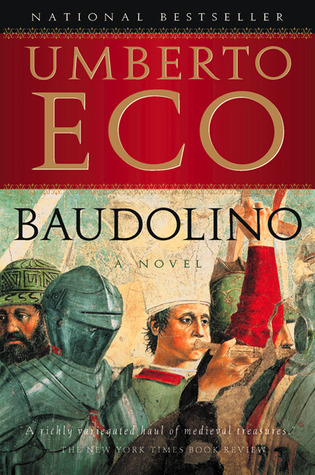In a time of disaster one can always revert to storytelling. At least that’s the tradition that Boccaccio hands down to us, and Umberto Eco, ever mindful of the past, picks up the conceit and spins the narrative of Baudolino around it. Creating an adventure story told amidst chaos and invasion, Eco’s latest novel marks his return to historical fiction, the genre that endeared him to the public with the enormously successful The Name of the Rose.
It is April of 1204, and, with the sack of Constantinople raging in the background, the novel’s rogue protagonist Baudolino relates the story of his life to the Byzantine historian Niketas Chroniates. An unreliable narrator, Baudolino seamlessly weaves fact and fiction, creating simultaneously a fable and a history of his days. Baudolino’s life as a young Italian peasant is radically changed one day when the German Emperor Frederick Barbarossa stumbles upon him in the midst of the woods. Entranced by his smooth talking, the Emperor decides to adopt him. From that moment Baudolino is treated to the best education the Middle Ages can provide, first under the direct tutelage of a bishop and later at the famed University of Paris. His earliest caretaker, Bishop Otto, spots his talents for inventing tales immediately, telling him:
If you want to become a man of letters and perhaps write some Histories one day, you must also lie and invent tales, otherwise your History would become monotonous. But you must act with restraint. The world condemns liars who do nothing but lie, even about the most trivial things, and it rewards poets, who lie only about the greatest things.
As an adult, Baudolino becomes the advisor, friend, and emissary of the emperor, and in his position of power promptly sets out to lie about “the greatest things,” enjoying the rippling effect that his fictions have on the society around him. With the joviality of Falstaff and the cunning of Machiavelli, he creates counterfeit church relics, fabricates letters from imaginary rulers that sway the decisions of governments near and far, and writes poems that get attributed to a different author. The great events at court, the motions of the empire, and the superstitions of the people all trace their roots to Baudolino’s love for a good practical joke.
Eco recreates medieval Europe lovingly; the period’s political upheavals are chronicled accurately and with attention to historical fact. But the events of the past provide only the background for the novel’s fantastical quest into the unknown, a quest where all medieval dreams for a land beyond the real and for the desirable Other merge into one. Baudolino and his comrades journey to find the legendary kingdom of Prester John, the ruler of a Utopian Christian empire thought to be far beyond the eastern-most limits of Byzantium. Their quest is a cross between the search for the Holy Grail and a tour of a cabinet of wonders; on their way to John’s imaginary kingdom they encounter manticores, pygmies, dog-headed cynocephali, creatures with eyes in their chests and hypatias, creatures that are half-virgin and half-goat.
Layered in with this mix of fantasy and reality, Eco indulges the reader (and himself) with countless learned digressions, on everything from the physics of a vacuum to the nature of God. Such diversions entertain, to be sure, and the novel’s descriptions as a whole are enchanting, but these surface details cannot hide the lack of well-wrought characters throughout the narrative. Baudolino remains from the opening chapter the only character of substance, and even his trickeries and sleights of hand become mechanical by the middle of the novel. The narrative operates creakily at times, with Niketas the historian interrupting Baudolino’s tale systematically at the onset and closure of chapters. Ostensibly his interruptions serve to point out inconsistencies in Baudolino’s story, highlighting probable fibs and fictions in the account (“`Forgive me…’ Niketas said, `so he was going back into Italy for the third time?’” Baudolino replies, “ `No, the fourth. Wait..it must have been the fifth, I think.’”), but after a while the disruptions become a superfluous reminder of the story’s outer casing, the narrative’s chief trick announcing itself with the regularity of a cuckoo clock. The meta-literary gestures fall short, calling into question the effectiveness of the outer narrative. With its charming air of a literary cabinet of curiosities, Baudolino is reminiscent of Eco’s earlier work The Island of the Day Before, but ultimately fails to provide a gripping narrative to support its learned exterior.

